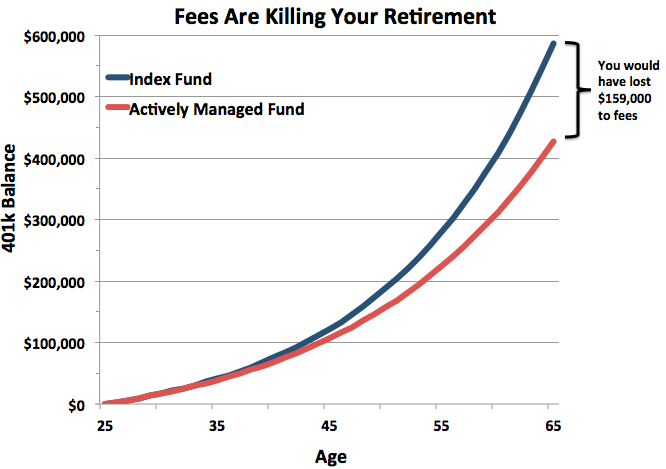ETFs vs. Index Funds in your 401(k)
As an adviser at Smart401k, I get to evaluate and provide advice on a lot of 401(k)s.  Mutual funds and company stock are typically the only type of offerings in an employer plan; however, there have been some of late that have included exchange-traded funds (ETFs) as core holdings.  For those who have a brokerage option through their 401(k), you also have the ability to select ETFs.  So, I thought I’d explain what ETF’s are and some of their pros and cons.  And, since most ETFs track indexes, I will compare them to mutual funds that track indexes.
What is an ETF?
An ETF is essentially a mutual fund that trades throughout the day on an exchange.
In an ETF, capital gains or losses only result when you sell the ETF, whereas in mutual funds capital gains or losses occur as the fund managers sell off investments within the fund; however, this benefit would not be extended to a 401(k) since it is a tax deferred plan.
Most ETFs track an index. such as the S&P 500 or MSCI EAFE .  There are other types of ETFs, such as commodity, currency and actively managed, but they currently aren’t as popular or as prevalent.
ETFs vs. Index Funds
ETFs can be bought and sold throughout the day while mutual funds trade only at the closing market price.
Like stocks, ETFs can also be sold short for those thinking the underlying index’s value will decline or bought on margin using borrowed money from a broker.  This typically won’t be allowed in the core account of your 401(k).
ETFs are bought and sold in what are called board lots (standard trading unit), which typically is 100 shares.    Mutual funds on the other hand can be bought and sold in partial shares.
401(k) dividends in index funds are reinvested back into the fund immediately, whereas most ETFs will accumulate dividends for a quarter and then either reinvest or pay them out to you.  In the brokerage portion of a 401(k), or non-employer sponsored account, the option of having dividends from mutual funds paid out to you is also typically available.
ETFs offered in the brokerage portion of your 401(k) typically allow you to buy or sell shares throughout the day, giving you greater flexibility on when to make trades.  (On the flip side, this can be seen as a negative aspect as well, and is discussed below).
When purchasing or selling ETFs through the brokerage option of your 401(k) you can provide certain instructions on when to do so.  For example, you can put in an order to purchase at a certain price.  If the ETF doesn’t hit that price you don’t buy it.   For an index fund on the other hand, you can only buy at the closing price of the day.
Why Index Funds?
Typically ETFs have a brokerage fee/commission for buying or selling, whereas most index funds are transaction fee free.
Since ETFs can be traded throughout the day, short term speculation or day trading can result, which often times leads to lower returns for the average individual investor.
The price of an ETF is determined by supply and demand.  Low demand for an ETF can drive the price below the NAV of the actual holdings in the ETF. 
Currently, ETF’s are not widely offered through company sponsored retirement plans.  I still only come across a new plan every few weeks.  When ETFs are available in a 401(k) it’s typically in one of two ways; either all the funds offered are ETFs or only a portion of the fund line-up is comprised of ETFs.  If ETFs are your only choices, you should treat them the same as if you had index funds and invest based on your current situation.  However, if your plan has added a few ETFs to compliment your other choices you need to ask yourself if the freedom to purchase a fund throughout the day outweighs the potential commission fees?  Also, be sure to analyze the potential fees and compare them to the other choices offered in your plan to see if it matches your investment objectives.  If you are still not sure if ETFs are right for you, consider speaking to an independent adviser to assist you with this important decision.
As always, feel free to contact me to discuss ETF’s further.















